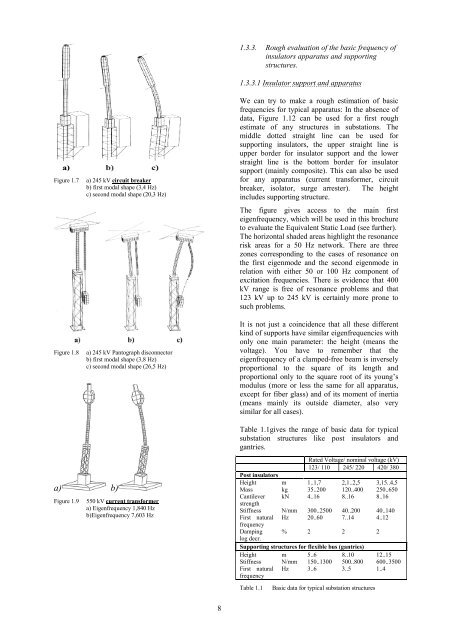The mechanical effects of short-circuit currents in - Montefiore
The mechanical effects of short-circuit currents in - Montefiore
The mechanical effects of short-circuit currents in - Montefiore
Create successful ePaper yourself
Turn your PDF publications into a flip-book with our unique Google optimized e-Paper software.
Figure 1.7 a) 245 kV <strong>circuit</strong> breaker<br />
b) first modal shape (3,4 Hz)<br />
c) second modal shape (20,3 Hz)<br />
Figure 1.8 a) 245 kV Pantograph disconnector<br />
b) first modal shape (3,8 Hz)<br />
c) second modal shape (26,5 Hz)<br />
a) b)<br />
Figure 1.9 550 kV current transformer<br />
a) Eigenfrequency 1,840 Hz<br />
b)Eigenfrequency 7,603 Hz<br />
8<br />
1.3.3. Rough evaluation <strong>of</strong> the basic frequency <strong>of</strong><br />
<strong>in</strong>sulators apparatus and support<strong>in</strong>g<br />
structures.<br />
1.3.3.1 Insulator support and apparatus<br />
We can try to make a rough estimation <strong>of</strong> basic<br />
frequencies for typical apparatus: In the absence <strong>of</strong><br />
data, Figure 1.12 can be used for a first rough<br />
estimate <strong>of</strong> any structures <strong>in</strong> substations. <strong>The</strong><br />
middle dotted straight l<strong>in</strong>e can be used for<br />
support<strong>in</strong>g <strong>in</strong>sulators, the upper straight l<strong>in</strong>e is<br />
upper border for <strong>in</strong>sulator support and the lower<br />
straight l<strong>in</strong>e is the bottom border for <strong>in</strong>sulator<br />
support (ma<strong>in</strong>ly composite). This can also be used<br />
for any apparatus (current transformer, <strong>circuit</strong><br />
breaker, isolator, surge arrester). <strong>The</strong> height<br />
<strong>in</strong>cludes support<strong>in</strong>g structure.<br />
<strong>The</strong> figure gives access to the ma<strong>in</strong> first<br />
eigenfrequency, which will be used <strong>in</strong> this brochure<br />
to evaluate the Equivalent Static Load (see further).<br />
<strong>The</strong> horizontal shaded areas highlight the resonance<br />
risk areas for a 50 Hz network. <strong>The</strong>re are three<br />
zones correspond<strong>in</strong>g to the cases <strong>of</strong> resonance on<br />
the first eigenmode and the second eigenmode <strong>in</strong><br />
relation with either 50 or 100 Hz component <strong>of</strong><br />
excitation frequencies. <strong>The</strong>re is evidence that 400<br />
kV range is free <strong>of</strong> resonance problems and that<br />
123 kV up to 245 kV is certa<strong>in</strong>ly more prone to<br />
such problems.<br />
It is not just a co<strong>in</strong>cidence that all these different<br />
k<strong>in</strong>d <strong>of</strong> supports have similar eigenfrequencies with<br />
only one ma<strong>in</strong> parameter: the height (means the<br />
voltage). You have to remember that the<br />
eigenfrequency <strong>of</strong> a clamped-free beam is <strong>in</strong>versely<br />
proportional to the square <strong>of</strong> its length and<br />
proportional only to the square root <strong>of</strong> its young’s<br />
modulus (more or less the same for all apparatus,<br />
except for fiber glass) and <strong>of</strong> its moment <strong>of</strong> <strong>in</strong>ertia<br />
(means ma<strong>in</strong>ly its outside diameter, also very<br />
similar for all cases).<br />
Table 1.1gives the range <strong>of</strong> basic data for typical<br />
substation structures like post <strong>in</strong>sulators and<br />
gantries.<br />
Rated Voltage/ nom<strong>in</strong>al voltage (kV)<br />
123/ 110 245/ 220 420/ 380<br />
Post <strong>in</strong>sulators<br />
Height m 1..1,7 2,1..2,5 3,15..4,5<br />
Mass kg 35..200 120..400 250..650<br />
Cantilever<br />
strength<br />
kN 4..16 8..16 8..16<br />
Stiffness N/mm 300..2500 40..200 40..140<br />
First natural<br />
frequency<br />
Hz 20..60 7..14 4..12<br />
Damp<strong>in</strong>g<br />
log decr.<br />
% 2 2 2<br />
Support<strong>in</strong>g structures for flexible bus (gantries)<br />
Height m 5..6 8..10 12..15<br />
Stiffness N/mm 150..1300 500..800 600..3500<br />
First natural<br />
frequency<br />
Hz 3..6 3..5 1..4<br />
Table 1.1 Basic data for typical substation structures











